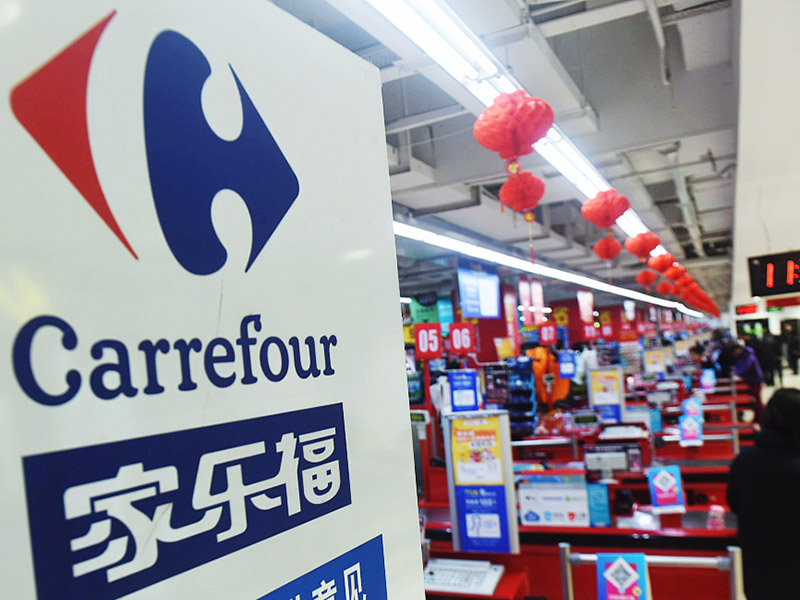Carrefour is a French retailer with a successful history of being China’s largest and fastest growing foreign retail stores in 1995. However, with the country’s digitalisation in 2010, Carrefour has failed to adapt with the changing consumer and market behaviour which led to its exit in one of the world’s largest e-commerce markets. In this article, the author has cited Carrefour’s successes and failures – from its management strategies to business expansion plans which can become a competitive imperative of learning for multinational companies and industries who need to upskill their approach towards the digital era before it becomes too late for them.
On 23rd June 2019, the French retailer Carrefour, the second-largest retailer worldwide sold 80% of the share of its Chinese stores to Suning International, part of the Suning Group, a Chinese retailer. By then, this used-to-be largest foreign retailer in China has been perceived exiting from China’s market, followed by similar actions taken by the UK retailers B&Q, which sold its 70% stake to Chinese company Wumei Holding in 2014 and Tesco, which sold its 80% share to China Resources Enterprise in 2017. It is important to reflect, after 24 years of operations, why such a worldwide large retailer has taken their steps out of the fastest-growing consumer market, where Carrefour used to be the fastest-growing among all foreign retail companies.
A brief history of Carrefour’s entry and expansion in China can be summarised into three phases.
1995-2001: Market Entry and Development Phase
Carrefour entered China in 1995 through a joint venture and opened the first largest hypermarket in Beijing – Beijing Chuangyi Store. Taking the first-comer advantages, Carrefour had remained as the fastest-growing foreign retailers in China during its operation for about two decades until the Chinese market became digitalised in 2010.
2002-2008: Fast Expansion Phase
Carrefour expanded throughout China in just a few years, led by its China CEO Shi Lerong. Between 2003 and 2006, Carrefour was the fastest expanding foreign retailers in China, with over 10 stores opening each year. During this time, Carrefour had established several flagship stores and procedures in China. In 2004, Carrefour introduced its first fresh food store called Guanjun Supermarket in Beijing. In 2011, Carrefour set up a top-level food security lab in its Shuangjing Store in Beijing, which was the first of this kind in China. The lab links to other 42 smaller labs to enhance food security, becoming an example of the provision of high-quality food.
2009-2018: Decline and Rescuing Phase
Slowing down expansion
In 2009, RT-Mart from Taiwan, replaced Carrefour China by owning the largest number of retail stores among foreign investors in China’s retail industry. In 2010, online retailing or e-tailing started to soar in China. By 2017, China has become the world’s largest e-commerce market, accounting for 40% of the value of worldwide e-commerce transaction, up from less than 1% in 2007. China’s online retail market has also become the world’s largest, with 38% annual growth rate (US$830 billion), compared to 14% in the US. To respond to the changing habits of Chinese consumers from in-store shopping to online shopping together with the increase in rent especially in the 1st and the 2nd tier cities, where Carrefour opened most of its hypermarkets, the retailer started to close some stores. Carrefour China closed its Xiaozhai store in Xi’an, Northwest of China, being its first store closure. By the end of 2015, Carrefour had 228 stores. In the same year, it closed 18 stores to 210 until its exit in 2019.
Variating retail formats
To respond to Chinese consumers’ preferences for convenience, Carrefour opened its first neighbourhood store in 2014 – Carrefour Easy and Carrefour Express convenience stores in affluent residential areas in Shanghai, targeting middle-class residents. These were directed by its new CEO in China Tang Jianian (Thierry Garnier). The fast growth of its convenience stores was contributed to Carrefour’s both store and sales growth rate in 2016 according to the data from China Chain Store and Franchise Association (CCFA), which ranked Carrefour as the 11th largest retailer by sales in 2016 being the 4th among foreign retailers in China.
In 2015, Carrefour introduced its online shopping tool to boost its market share. In the same year, Carrefour opened its first shopping mall in Beijing, where the company rents out its store spaces to other retailers to attract customer flow and spread the cost. It was also the first time that Carrefour purchased land to build and manage a mall, which was its biggest in Asia. This format offered Chinese consumers new experiences in shopping. One of Carrefour’s senior executives commented:
One hypermarket is about 8000 to 10000 square meters, a large mall is about 20000 to 30000 square meters. Apart from a hypermarket, the mall includes 65% of rent-out space for restaurants, a cinema, KTVs, a gym, a SPA, beauty businesses, children’s education places, clothes shops, and so on … The purpose of our shopping malls is to attract customer flow through various lifestyle formats (finance.sina news, 2015).
In 2018, Carrefour opened its first smart retail store, Le Marche. The retailer offered many private labels in its stores such as Carrefour Quality Line and French Touch brands, targeting middle-class consumers. However, this action was a little late to catch up with the market needs, by the exit, the retailer had only 24 smart retail stores. It could not replicate its small-sized store model in France (over 6000 stores) in China.
Developing distribution systems
Only until in 2015, Carrefour started to have its own distribution centre after 20 years of operations in China. By the end of 2017, the retailer set up six large warehouse logistics distribution centres in Hunshan (East China), Wuhan (middle China), Chengdu (Southwest China), and Tianjin (North China).
Nevertheless, the above strategies did not help Carrefour to regain its development potential in China’s market.
2019: Market Exit
Apparently, Carrefour took corresponding strategies for its development in China at both the pre-digital and the post-digital age. However, why did this retail giant just fail in the market? There are several main internal and external reasons.
Short-sight of management without a long-term strategy
Carrefour’s catching-up strategies used to respond to the fast-changing digitalised retail sector in China were lack of focus. For example, the new modern retail formats Carrefour established as mentioned above including Guanjun Supermarkets, Carrefour Easy, and Le Marche were developed by a conservative and trying-out attitude. By doing so, Carrefour kept its conventional behaviours of charging fees from its suppliers, continuously reducing expenditure on human resources, and other expenses in order to improve profits, reflecting the similar strategies the retailer used to make a profit in the first two decades of development in China. By this conservative approach and not investing sufficiently on human resources, financial resources, and material resources, Carrefour was unable to transit successfully in response to the fast digitalisation process in China.
Short-term performance management
It was Carrefour’s performance management system that led to the short-sight management approach. This system was implemented by its staff from the middle to the top level, from boards of directors to managers, with a type of utilitarian mentality. This approach was largely derived from the focus of profit-making of the Carrefour Group. Since the previous Carrefour China CEO Luo Guowei (Eric Legros), a consultant and a professional manager, had taken the position in 2006, the management orientation of the retailer in China became more toward profit-seeking. These were represented by their cost-reduction strategies, the establishment of CUU (city-based merchandise centres) and new product development concepts. Specifically, when the sales increased, related expenses could be increased; otherwise decreased. Such tight financial policy affected the long-term competitive advantage of the company.
The profit-orientated performance management system also resulted in the short-term employment of senior managers. Carrefour hired its professional managers in China up to three years only, with a maximum once re-election. This period is insufficient for long-term business planning and vision. As a result, the professional managers focussed more on their financial performance during their time of service. Consequently, their successor may have to deal with any challenges left over by the former manager.
Late development of the supply chain management system and over-centralisation
Carrefour did not have its own distribution centre until 2015. By then, most of the goods had been delivered by suppliers to stores. The previous system caused inefficiency for managing both costs and sustainable growth. The reason for this late development was derived from the lack of emphasis on distribution centres and logistics management.
Early 2015, Carrefour reduced its 24 CCU (city-based merchandise centres) to six, located in various areas, including those in Shenyang, Northeast; Beijing, North; Shanghai, East; Wuhan, Middle; Chengdu, Southwest; and Guangzhou, South China. By doing so, Carrefour centralised its merchandise systems in China that was established in 1995 when the retailer entered the Chinese market. After this new establishment, the regional directors of these six big regions terminated their duties for supply and started to focus on store operations. The CCUs contributed to the increased centralisation of power from stores or store managers to each CCU, making the profit more transparent, leading to an increased profit of Carrefour China as a whole.
However, the CCUs replaced parts of the previous role of each region, and each region needed to allocate the purchasing power to an increasing number of employees who were responsible for supply. Consequently, Carrefour shifted staff from stores to CCUs, thus reducing the staff in each store from 15 employees in each department before CCUs’ establishment to six after. As a consequence, many experienced store managers left Carrefour and the morale of store staff became low.
Final Remarks
Overall, the challenges that Carrefour faced in China was also largely influenced by the fast growth of online retailing, with one-stop shopping becoming gradually unfavourite by Chinese consumers. The hypermarket format has entered its decline period in the digitalised Chinese retail sector. In addition, multinational retailers are not in the first position to realise the changes in the fast-changing Chinese market, especially, the strategic decisions of the multinationals are mainly made by their home-country management system. When the home-country decision-makers have realised the changes in China, it is often too late.
About the Author
 Dr Lisa Qixun Siebers (Qixun.Siebers@gmail.com) is from The Institute for Retail Studies, Stirling Management School, University of Stirling, Scotland, UK.
Dr Lisa Qixun Siebers (Qixun.Siebers@gmail.com) is from The Institute for Retail Studies, Stirling Management School, University of Stirling, Scotland, UK.
































































